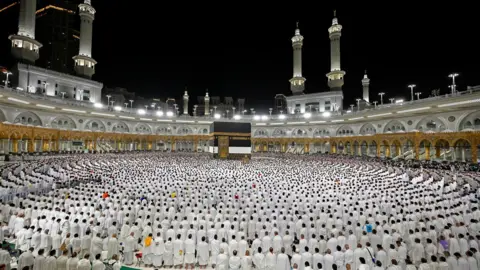Saudi Arabia seeks to prevent heat deaths as Hajj pilgrimage begins
 Saudi Press Agency/Handout via Reuters
Saudi Press Agency/Handout via ReutersMore than 1.4 million Muslims have begun this year's Hajj pilgrimage in the Saudi holy city of Mecca, a year after 1,300 people died, mostly due to the extreme heat.
Saudi authorities say they have stepped up safety precautions for the annual event.
They have planted thousands of trees and installed hundreds of cooling units to help alleviate temperatures forecast to reach 44C (111F).
They have also banned children under 12 and warned pilgrims attempting to undertake the Hajj without an official permit that they face a $5,000 (£3,685) fine and a 10-year entry ban.
As of Sunday, officials said they had stopped more than 269,000 people from entering Mecca.
Officials said 80% the pilgrims who died last year, including hundreds of Egyptians and Indonesians, were unregistered and therefore lacked access to proper air-conditioned accommodation, transport and other amenities when temperatures reached 51C.
Many Muslims cannot afford an official Hajj package - which can cost from $4,000 to $20,000 depending on their country of origin, length of stay and level of comfort - and so enter the Gulf kingdom on tourist or visitor visas.
 Saudi Press Agency/Handout via Reuters
Saudi Press Agency/Handout via ReutersThe Hajj is one of the five Pillars of Islam and takes place in the 12th month of the Islamic lunar calendar.
It is the journey that every adult Muslim must undertake at least once in their lives if they can afford it and are physically able.
On the first day of the Hajj, male pilgrims were required to change their clothes for two white cloths and enter the state of Ihram. Women put on modest clothing and covered their head, but not their face.
The pilgrims headed to Mecca's Grand Mosque, Islam's holiest site, and circled the Kaaba seven times - a ritual known as tawaf. They could also walk seven times between the hills of Safa and Marwa, known as sai.
They then travelled to Mina, 5km (3 miles) away, where they will spend the night in a tent city before heading on Thursday to Mount Arafat, where the Prophet Muhammad is said to have delivered his final sermon.
The Saudi health ministry urged the pilgrims to follow strict guidelines to mitigate the effects of the heat, including avoiding exposure to the sun between 10:00 and 16:00, using umbrellas to shade themselves, and drinking water regularly.
Shaded areas have been enlarged by 50,000 sq m (12 acres) and more than 400 cooling units have been installed, according to the Hajj minister.
The cooling system in the Grand Mosque is the largest in the world, according to state TV.
More rubberized and cooled roads have also been built to reduce surface temperatures, and artificial intelligence will be used to monitor a fleet of drones and help manage crowds.
In 2015, more than 2,300 people were reportedly killed in a stampede in Mina.
